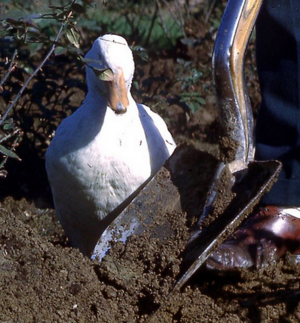Spades

Spades are used to dig in the earth, to make holes, to loosen or turn over soil, slicing turf, to compact soil after a hole or indentation is filled back in or to pack down soil/organic matter around plants.
Spades can be used in the garden, on farms and even at the beach for a bit of fun. The variety of possible uses means that there are spades in various shapes, lengths, widths and strengths.
Spade or shovel?[edit | edit source]
While it's commonplace to mix both words up, there is a difference:[1]
- A spade has a flat-bottomed edge intended for digging and cutting through soil
- A shovel has a broad-bottom and is intended for moving loose materials.
Types of spades[edit | edit source]
There are various types of spades available:
- Garden spade: This is a wide spade with a long handle, and has rests on it to help you to drive it into the soil (treaded).[1]
- Irish spade: This is similar to the garden spade but has a thinner head.[1]
- Sharpshooter: This is a narrow spade.[1]
- A turfing iron: This spade has a short, round head. It cuts and pares off turf.[1]
- Digging fork or grape: This is a forked spade and is used to loosen ground.[1]
- Beach or toy spades: These are made mostly for children to dig in the sand or to assist with gardening on a small and easy scale.
Things to look for in a spade[edit | edit source]
Choose good quality spades. In particular, check that the metal the spade is made from is tough and that it is securely attached to the handle. The handle and blade connection should be secure. A longer shank provides better support.
Check the handle. A handle on a spade should be well made, solid and sturdy. It should not split or break in your hands during use.
Selecting a spade[edit | edit source]
Choose a spade that is suitable for your height. Using a spade for digging is hard physical work and a spade that is either too tall or too short for your height can add strain to your muscles and cause pain. The only way you'll know what feels right is to test a few. When visiting the sales place, hold them and do digging motions, to see how the spade feels. If borrowing from a neighbour or friend, try it out to see whether it's the right one for you... or not.
Always buy the best tools that you can afford. The initial expense will be repaid by the tools lasting for years and not wearing out. Cheaper tools snap, break and fall apart quickly and are often much harder to repair.
Caring for your spade[edit | edit source]
Clean it after each use and ensure that it is not stored caked in soil. Soil left on the spade solidifies and makes for harder cleaning work.
Oil the wood part of the spade regularly. Oil can also be used on the metal edges, to keep the sharp edges.